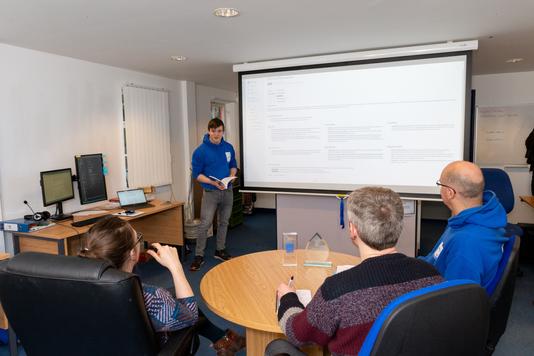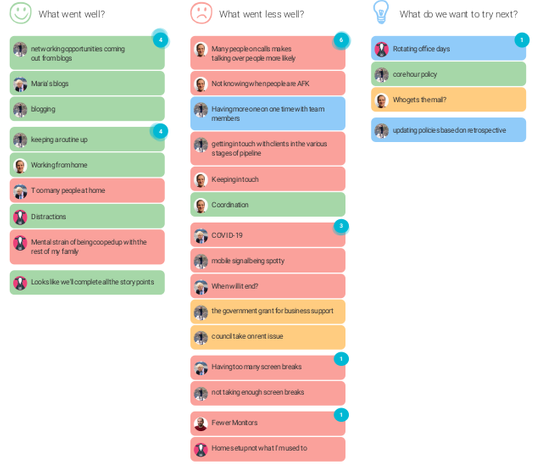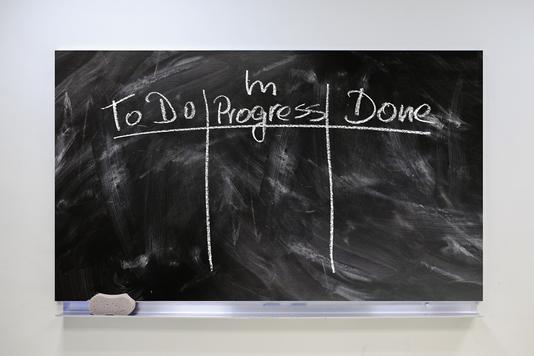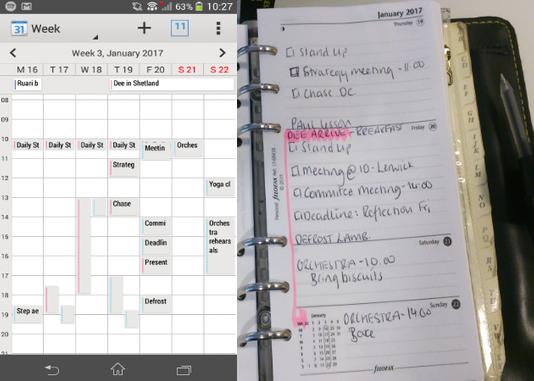
The Mesomorphic Guide to Holding Your Own Retrospective
- By Maria Bell
- 23 March
We showed the value of a retrospective during our last blog. Now it's time to find out how to have one of your own!
Working from home is not uncommon in the IT industry, so here is a quick start guide to get started.

Part of the Remote Working series:
Part 1: The Mesomorphic Guide to Working From Home
Part 2: Communication When Working Remotely
Part 3: You Can With a Kanban
Part 4: Looking Back Over Our First Week of Having a Fully Remote Team
Part 5: The Mesomorphic Guide to Holding Your Own Retrospective
If, like us, you’re now working from home as part of your effort to help delay the spread of COVID-19 you may be wondering how you and your company can adapt to these new working conditions.
Remote working is not an uncommon activity in the IT industry, and as such we have put together a blog series to share our hints and tips for working from home.
To start out off, here is a quick start guide to get going.
This is the first challenge. Do you have a spare room? Or space in your bedroom? Or a door that allows you to close off your dining room? Perhaps you have a summer house? You need to find a space which is outwith the main through flow of your home. At first sight, my dining room would seem like an ideal situation. It’s got a nice size table, near the kettle and also the bathroom. Unfortunately however it’s right in the middle of the through flow of my house. This is suitable for short spells for working at home, however for the longer term I’ve set up my home office in my spare room. You will need to look closely at your home to find a space where you can find some form of peace, whether you live in a one bedroom flat or a mansion. Other considerations are:
Now you’ve found your space, I recommend carrying out an assessment of your working environment. More details on assessing your work space can be found here.
Your office health and safety representative is ultimately responsible for ensuring that HSE legislation is adhered to in your company, but why not help them out? If you need to purchase certain equipment to make your working environment a comfortable safe space then you’ll need to assess it yourself until your HSE advisor can review your work station with you remotely. Be sensible with your expenses though. I doubt your company would be impressed if you put in expenses for a new kettle to reduce the number of trips to the kitchen. However, think about cables, extension leads and perhaps a deskspace organiser.
This is the next challenge. You may need to set ground rules for both yourself and anyone that you share your living space with. If you live by yourself, you may feel that this isn’t as important to you, but you’d be surprised! We’ll cover more of this in ‘Setting up a routine’
If you share a living space, it’s important to manage expectations not only for yourself but for those you live with. Now I’m not saying that locking yourself away is the simple solution here. Let those you live with know times when you can’t be disturbed, for example when you know you have meetings arranged, calls to make or you have a deadline to meet. Remember though, that it may not be just you who is in the same boat. We’ll talk more about stand up meetings later on, but find out if whoever you’re living with has any meetings and deadlines that you need to know about as well. Write up the ‘do not disturb times’ on a piece of paper and stick it to the fridge or somewhere visible so it’s captured somewhere for everyone to see.
If you have little ones, chances are you’ll need to tag each other out at points during the day to maintain your sanity. You’re going to be juggling multiple responsibilities, however having a plan and clear lines of communication will help smooth things over.
It’s very easy to slip out of your working routine when working from home. For the sake of your own sanity and those around you, establishing a morning routine early on is essential. It helps you to not fall into the habit of rolling out of bed, through to your home office and then back to bed. It helps you become motivated and mentally ready to switch into work mode.
Working in your jammies may be seen as a perk of working from home for some but for others, not setting up a routine which gets you into work mode can be quite detrimental to your work as well as your mental health. Something that I find helps me, is having quiet time in the morning helps me reflect and plan my day whilst I’m eating my breakfast, or when the weather allows it, I have my first cup of coffee either at my front door or out in the garden. Then it’s time for a shower and get myself out of my jammies. A trick I learned from my uncle is to wear my office clothes when I’m in work mode. He worked from home for over 20 years and still wore a tie when he sat at his home desk regardless of whether he was meeting clients or not. It’s about finding what gets you into the right mindset.
We’ll be covering communication tools and tips in our next blog, however for now, it’s important to stress that communication is not only important in your living environment but also to make sure channels are open with the rest of your team.
I would like to introduce the idea of a team Stand Up early in the morning. Stand Up is what it says on the tin. With your colleagues, you all stand up and take it in turns to state what you did yesterday, plan to do today, and whether you have any impediments that others need to know about. Each person has 30 seconds to say their piece. It’s important to keep it brief. By holding this meeting standing up regardless of whether you’re in the same room or working remotely, it will help keep the meeting short and efficient. The key outcome is knowing what is happening with the company as a whole and may identify priorities or impediments you may not have been aware of.
Depending on your company size and structure you may think this idea is not feasible, however knowing what each department did yesterday, today, and whether there are any impediments is a really useful tool to ensure the smooth running of the company. It’s time to start thinking outside of the box. For larger teams, each department will need their own individual Stand Up. Then a department representative will attend a stand up which includes all departments to repeat the process for the entire company.
Again, we’ll be covering more around this however working from home can make you feel that you don’t always know where to start. This is one of the many benefits of stand up, it helps you formulate your plan for the day.
I’d also recommend spending 10 minutes in the morning writing your to do list to help keep you focused. There are many tools out there, but for me I have my paper diary which I use tick boxes and stars. The tick boxes represent the to do’s and the stars represent the activities I’ve done outside my to do. This method works for me like a charm, however it may not work for everyone. Again, find out what works for you. Perhaps post-it notes on a wall? A list on your phone? Think about your processes and make them work for you.
It’s so easy to get stuck into work and then forget to take a break, or perhaps you find it difficult to sit down and focus. I find that timeboxing is a really useful technique to sit down and know I have a fixed amount of time to do a certain task. I use the Pomodoro technique and set an alarm on my phone, or set a reminder in my Google calendar which pings me when I need to start or stop a certain task.
It’s important to make sure you continue to take breaks like you would do in the office. I find it easy to get stuck in front of a screen for hours at a time, and then wonder why I’m getting a headache. You need to make sure you’re taking care of yourself.
Whether you’re an avid water drinker or not, chances are you’ll have a water bottle or a pint glass floating around the house. It’s time to use it! My water bottle not only helps me to keep hydrated during the day, but it also forces me to take breaks when it’s empty. I’m sure you’re aware of the benefits of keeping hydrated during the day, but you’ll be surprised at the effects that you experience if you don’t keep your fluids up.
So that’s it for today. Over the next few blogs we will be covering topics such as time management, remote working with your teams, communication, and task management. If you have any suggestions from your own experience or have any questions please comment or get in touch with us at contact@mesomorphic.co.uk.

We showed the value of a retrospective during our last blog. Now it's time to find out how to have one of your own!

We're always looking at ways we can continuously improve our processes, so today we had a retrospective which focused on how this week has gone.

Task management is key for any organisation regardless of size and location. In this blog I will walk you through my own process for task management and look at how a Kanban board help keep tasks on track.

Keeping communication lines open can be an issue whether working remotely or in the same building. This blog looks at some of the tools availiable and how we achieve it in Mesomorphic.

I'm going to be honest. Originally I had started writing this blog purely to discuss the benefits of using software in a business environment.